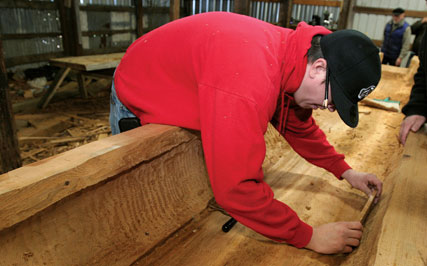Culture
Tribal members carving first river canoe seen in Grand Ronde in a century

On Tuesdays and Thursdays, it is all happening in an unassuming steel shed over the rickety wood bridge behind the Tribe's Recovery House on Hebo Road.
A slew of folks from the Cultural Resources Department, as well as knowledgeable volunteers and well-wishers, have been working for the last month on the first river canoe that the Grand Ronde people have built certainly since Restoration and likely since the early 1900s.
In fact, says Tribal member Brian Krehbiel, Cultural Education specialist, in researching the canoe design, "I haven't found any proof of a canoe (like this) being made from Grand Ronde natives since we were marched here in the 1800s."
The 16-foot, three-to-four person, shovel nose cedar canoe sits near another, also in process, almost twice as large and destined for the ocean or for large rivers like the Columbia, according to Krehbiel.
One day last week, he was using a pull blade to shave ribbon after ribbon of beautiful old growth cedar that will, in the next month, leave behind a river canoe sitting on a soft, old growth forest-like floor where there was once just dirt and gravel.
In late March, the canoe will head to the Willamette Heritage Center at The Mill.
The process to take it there began late last year when discussions between Peter Booth, executive director of the Heritage Center, and Grand Ronde's Cultural Resources Manager David Lewis, also a Tribal member, led to the idea of a Native canoe exhibit now under way.
The river canoe seemed like a good idea, Lewis said, not only because it has not been seen in the Northwest in so long, but also because once the exhibit ends, the Tribe will have a canoe suitable for traveling the smaller waterways on the reservation.
Tribal Council supported the exhibit last year, Lewis said, and this year the Council provided $10,000 for the $30,000 project.
"We're building a canoe and a tradition that the Tribe will use in the years ahead," said Lewis.
Not only will the canoe be a stationary exhibit at the Salem museum, but the group plans to leave the texturing at the end of the process for a live demonstration.
The river canoe is being built in the Kalapuya or Willamette River style, said Tribal member Bobby Mercier, Language and Cultural specialist for the Tribe.
"Similar style canoes were found all the way down to northern California," he said.
The design for this canoe comes from drawings of this style of canoe last seen at Willamette Falls in 1831.
"They used horses after that," said Mercier.
In January, Tribal Elder and Site Protection Specialist Don Day selected the cedar log for the river canoe. The maintenance crew, including Tribal members Marcus Gibbons and Gregg Leno along with community member Kyle Towner (Siletz), brought it over to the shed on Hebo Road. They handled the heavy lifting with their equipment.
Day then brought in the wedges and the expertise with which the group divided the log in two. Tribal members Jeff Mercier, David Harrelson, Krehbiel and Lewis all helped with the splitting.
Among others who have helped with the project are Tribal Elder Bob Watson, an accomplished traditional woodworker whose oars hang in the Tribal Housing Authority building. His work is shown widely and well regarded.
Community member Darrell Pepper, another accomplished woodworker, said he "turned some plugs" to fill in knot holes in the canoe body.
"If I could do something worthwhile," he joked, "I would."
Tribal member Travis Mercier, Richard Sohappy (Yakama) and Tribal Elder Dolores Parmenter also pitched in on the carving.
Contributors brought their own tools, lent their tools to the project and the group purchased some very authentic and rare tools from a source they are keeping secret for the time being. Among those are a shipwright adze and big chisels called slicks.
Grand opening for the exhibit is Friday, April 8. Jonathan King, Ph.D., Keeper of the Department of Africa, Indian Ocean and Americas at the British Museum, is expected to speak on his work about American Northwest coast peoples, according to Lewis.
On the following Tuesday, April 12, the texturing demonstrations are slated to begin.
